Question
Question: A manufacturer considers that men and women workers are equally efficient and so he pays them at the...
A manufacturer considers that men and women workers are equally efficient and so he pays them at the same rate. He has 30 workers (male and female) and 17 units capital; which he uses to produce two types of goods A and B. To produce one unit of A,2 workers and 3 units of capital are required while 3 workers and 1 unit of capital is required to produce one unit of B. if A and B are priced at Rs.100 and Rs.120 per unit respectively. How should he use his resources to maximize the total revenue? Form the LPP and solve graphically.
Do you agree with this view of the manufacturer that men and women workers are equally efficient and so should be paid at the same rate?
A). 1260
B). 1130
C). 1290
D). 3421
Solution
Here in the given question we need to make the equations according to the given condition we have to find the equation of Z then we have to draw the graph and according to the graph we have to find the value of Z and find out where the Z is maximum or minimum we will put the value of corner points in the Z equation before starting the problem you have to read the question 2 to 3 times because the given data is not given in these type of questions we have to make the data by our own.
Complete step-by-step solution:
So according to the question,
Let x and y be the number of goods of type A and of type B respectively
Therefore, the number of labors =2x+3y
As 30 units of labour are available
∴2x+3y≤30
Similarly, Constraint for capital is
3x+y≤17
And non-zero constraints are
x≥0, y≥0
Objective function is
Z=100x+120y
Consider
2x+3y=30
For the point A here, we will put the value of x=0 in the above equation we will get,
2(0)+3y=30⇒+3y=30⇒y=330⇒y=10
Here we will get point A (0, 10)
Let’s go for the point B we will put x =3,
2(3)+3y=30⇒6+3y=30⇒3y=30−6⇒3y=24⇒y=324⇒y=8
So here we will get the point B (3,8)
2x+3y=30 passes through A (0, 10) and B (3,8)
Consider,
3x+y=17
Where x=3, then y=8
3(3)+y=17⇒9+y=17⇒y=17−9⇒y=8
Where y=0, then x=317
3x+(0)=17⇒3x=17⇒x=317
3x+y=17 passes through C(3,8)andB(317,0)
Further above two equations intersect at C(3,8), vertices of the feasible region are A(0,10),O(0,0),B(317,0)andC(3,8).
At, A(0,10),Z=100(0)+120(10)=Rs.1200
O(0,0),Z=100(0)+120(0)=Rs.0
B(317,0),Z=100(317)+120(0)=Rs.566.67
C(3,8),Z=100(3)+120(8)=Rs.1260
Thus, the maximum value of Z=Rs.1260 at x=3 and y=8.
Yes, the view of manufacturers that men and women workers are equally efficient is correct and so they should be paid at the same rate.

Hence, the answer is Rs.1260
Note: Alternate solution:
Let x units of A and y units of B be produced by the manufacturer. The price of one unit of A is Rs.100 and the price of one unit of B is Rs.120. Therefore, the total price of x units of A and y units of B or the total revenue is Rs. (100x + 120y).
Z=100x+120y....(i)
One unit of A requires 2 workers and one unit of B requires 3 workers. Therefore, x units of A and y units of B require (2x + 3y) workers. But the manufacturer has 30 workers. 2x + 3y s 30 workers
2x+3y≤30...(ii)
Similarly, one unit of A requires 3 units of capital and one unit of B requires 1 unit of capital. Therefore, x units of A and y units of B require (3x + y) units of capital. But the manufacturer has 17 units of capital.
3x+y≤17...(iii)
Thus, the given linear programming problem is
Maximize Z = 100x + 120y
subject to the constraints
